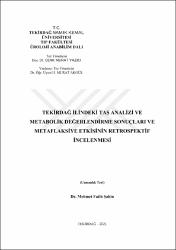| dc.contributor.advisor | Yazıcı, Cenk Murat | |
| dc.contributor.advisor | Akgül, Hacı Murat | |
| dc.contributor.author | Şahin, Mehmet Fatih | |
| dc.date.accessioned | 2022-04-06T06:50:09Z | |
| dc.date.available | 2022-04-06T06:50:09Z | |
| dc.date.issued | 2021 | |
| dc.identifier.uri | https://tez.yok.gov.tr/UlusalTezMerkezi/TezGoster?key=v7BkNnnepTnbhn8rNR77LeeQeRdCcEBEyhkd572LMLw7aR7dxU6YEqXMQDMRQOho | |
| dc.identifier.uri | https://hdl.handle.net/20.500.11776/4410 | |
| dc.description.abstract | ÖZET Çalışmamızda; taş açısından endemik bir bölgede yer alan Tekirdağ ilindeki taş analizi ve metabolik değerlendirme sonuçlarını sunarak bunlar ile hastaların demografik ve kişisel özelliklerini ve ilişkilerini saptamayı ve bunların metaflaksiye olan etkisini ortaya koymayı hedefledik. Bu amaçla, Ağustos 2018 ile Ocak 2021 tarihleri arasında kliniğimize başvuran, üriner sistem taş hastalığı olan 312 hastanın verileri incelendi. Bu hastalara taş analizi yöntemi olarak spektroskopik yöntem tercih edilerek taş analizi yapıldı. Taş analizi mevcut olan hastalardan 156 tanesine de 24 saatlik idrarda ve eş zamanlı olarak serumda metabolik değerlendirme yapıldı. Hastaların yaş, cinsiyet ve hastaların ikamet ettikleri merkezler; taşların taraf dağılımı, lokalizasyonu, dansiteleri, hacimleri ve 24 saatlik idrar ve serum parametreleri değerlendirmeye alındı. Üriner sistemde farklı lokalizasyonda mevcut olan taşlar da ayrı ayrı analiz edildi. Taş hastalığı erkek baskın, solda, üriner sistemde multipl lokasyonlarında, sıklıkla tek, steril idrar kültüründe ve çoğunlukla kent merkezinde ikamet eden hastalarda görülmekteydi. En sık tespit edilen taş çeşidi kalsiyum oksalat; en az görülen taş çeşidi ise ksantin taşıydı. En yüksek ortalama HU kalsiyum oksalat taşlarında, en düşük de ürik asit+amonyum ürat taşlarındadır. Kalsiyum içeriği arttıkça, taşın sertliği de artmaktadır. Ortalama taş hacmi en yüksek taş çeşidi sistin, en düşük olan ise ksantin'dir. En sık taş 50-59; en nadir 18 yaş altında görülmektedir. İdrarda en sık hiperkalsiüri, en az hipersistinüri; plazmada en sık hiperürisemi, en az hiperkalsemi görülmüştür. Metaflakside en sık potasyum sitrat kullanılmıştır. Sonuçta; ilimizdeki taş çeşitliliği ve predispozan metabolik bozukluklar incelendi ve kliniğe yansımaları değerlendirildi. Metabolik değerlendirmeye daha fazla önem göstermeli ve zaman ayrılmalıdır. | en_US |
| dc.description.abstract | A RETROSPECTIVE STUDY OF STONE ANALYSIS, METABOLIC EVALUATION RESULTS AND THEIR EFFECT ON METAFLAXY IN TEKIRDAG PROVINCE SUMMARY In our study; we aimed to present the results of stone analysis and metabolic evaluation in Tekirdag province, where is an endemic region in terms of stones, and to determine the demographic and personal characteristics and relationships of patients with these, and to reveal their effects on metaphylaxis. For this purpose, the data of 312 patients with urinary system stone disease who applied to our clinic between August 2018 and January 2021 were analyzed. Stone analysis was performed to these patients by using the spectroscopic method. The metabolic evaluation was performed in 24-hour urine and serum simultaneously to 156 of the patients with stone analysis. Age, gender, BMI of the patients, and the centers where the patients reside; the side distribution, localization, stone densities (HU), volumes, and 24-hour urine and serum parameters of the patients were evaluated. Stones in different localizations in the urinary system were also analyzed separately. The stone disease was predominantly in males, on the left side, in multiple locations in the urinary system, frequently single, with sterile urine culture, and mostly in patients residing in the city centers. The most frequently detected type of stone is calcium oxalate; the least common type of stone was xanthine. The highest mean HU is in calcium oxalate stones and the lowest in uric acid+ammonium urate stones. As the calcium content increases, the HU of the stone increases. The stone type with the highest mean stone volume is cystine and the lowest is xanthine. The most common stone patient age is 50-59; it is rarely seen under the age of 18. Hypercalciuria is the most common and hypercystinuria is the least common parameter; the most commonly hyperuricemia and least hypercalcemia were observed in plasma. Potassium citrate was used most frequently for metaphylaxis. 76 After all; the stone diversity and predisposing metabolic disorders in our city were examined and their clinical implications were evaluated. More attention and time should be devoted to metabolic evaluation. | en_US |
| dc.language.iso | tur | en_US |
| dc.publisher | Tekirdağ Namık Kemal Üniversitesi | en_US |
| dc.rights | info:eu-repo/semantics/openAccess | en_US |
| dc.subject | Üroloji | en_US |
| dc.subject | Urology | en_US |
| dc.subject | Üriner taşlar | en_US |
| dc.subject | Urinary calculi | en_US |
| dc.subject | Taş analizi | en_US |
| dc.subject | metabolik değerlendirme | en_US |
| dc.subject | metaflaksi | en_US |
| dc.subject | Stone analysis | en_US |
| dc.subject | metabolic evaluation | en_US |
| dc.subject | metaphylaxis | en_US |
| dc.title | Tekirdağ ilindeki taş analizi ve metabolik değerlendirme sonuçları ve metaflaksiye etkisinin retrospektif incelenmesi | en_US |
| dc.title.alternative | A retrospective study of stone analysis, metabolic evaluation results and their effect on metaflaxy in Tekirdag province | en_US |
| dc.type | specialistThesis | en_US |
| dc.department | Enstitüler, Tıp Fakültesi, Üroloji Ana Bilim Dalı | en_US |
| dc.identifier.startpage | 1 | en_US |
| dc.identifier.endpage | 91 | en_US |
| dc.institutionauthor | Şahin, Mehmet Fatih | |
| dc.relation.publicationcategory | Tez | en_US |
| dc.identifier.yoktezid | 689156 | en_US |



















